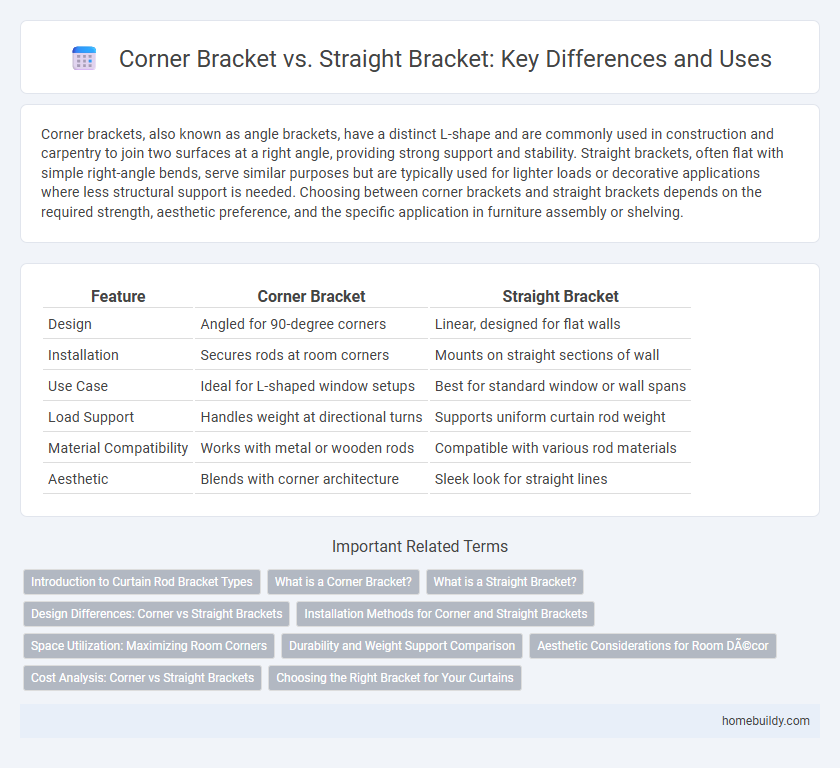Corner brackets, also known as angle brackets, have a distinct L-shape and are commonly used in construction and carpentry to join two surfaces at a right angle, providing strong support and stability. Straight brackets, often flat with simple right-angle bends, serve similar purposes but are typically used for lighter loads or decorative applications where less structural support is needed. Choosing between corner brackets and straight brackets depends on the required strength, aesthetic preference, and the specific application in furniture assembly or shelving.
Table of Comparison
| Feature | Corner Bracket | Straight Bracket |
|---|---|---|
| Design | Angled for 90-degree corners | Linear, designed for flat walls |
| Installation | Secures rods at room corners | Mounts on straight sections of wall |
| Use Case | Ideal for L-shaped window setups | Best for standard window or wall spans |
| Load Support | Handles weight at directional turns | Supports uniform curtain rod weight |
| Material Compatibility | Works with metal or wooden rods | Compatible with various rod materials |
| Aesthetic | Blends with corner architecture | Sleek look for straight lines |
Introduction to Curtain Rod Bracket Types
Corner curtain rod brackets are designed to secure rods at 90-degree angles, ideal for window corners or bay windows, while straight brackets support rods on flat walls. These brackets vary in size, material, and load capacity, impacting the stability and aesthetic of curtain installations. Selecting the appropriate bracket type ensures proper curtain functionality and complements the window architecture.
What is a Corner Bracket?
A corner bracket is a specialized curtain rod support designed to fit at the junction where two walls meet, allowing curtains to wrap seamlessly around a corner window. Unlike straight brackets that mount on flat walls, corner brackets enable smooth transitions in L-shaped or bay window setups by securely holding rods at a 90-degree angle. These brackets enhance both aesthetic appeal and functional coverage by accommodating unique window configurations.
What is a Straight Bracket?
A straight bracket is a type of curtain rod support designed to mount flush against a flat wall, providing stability for rods positioned in a linear arrangement. Unlike corner brackets that accommodate rods turning at 90-degree angles, straight brackets are ideal for holding curtain rods above standard windows or along extended straight wall spaces. These brackets are essential for ensuring even weight distribution and a secure hold for single, straight curtain rods.
Design Differences: Corner vs Straight Brackets
Corner curtain rod brackets feature an angled design that allows rods to turn 90 degrees at room corners, providing seamless support for window treatments wrapping around walls. Straight brackets have a linear, elongated shape designed solely for flat wall mounting, offering strong, direct support for rods spanning window widths. The choice between corner and straight brackets depends on room layout and curtain style, with corner brackets enabling more complex installations and straight brackets delivering straightforward, sturdy support.
Installation Methods for Corner and Straight Brackets
Corner bracket installation requires precise measurement and secure mounting at a 90-degree angle to support rods around window corners, often involving wall anchors for added stability. Straight bracket installation is simpler, typically mounted linearly along the wall using screws directly into studs or drywall anchors for uniform support. Both methods demand level alignment and sturdy fastening to ensure the curtain rod remains stable and functional.
Space Utilization: Maximizing Room Corners
Corner brackets optimize space utilization by allowing curtain rods to fit snugly into room corners, creating seamless transitions between walls and making use of otherwise wasted areas. Straight brackets, while effective for flat surfaces, do not capitalize on corner spaces, often leaving gaps that reduce overall room efficiency. Utilizing corner brackets enhances the functional and aesthetic potential of window treatments in compact or irregularly shaped rooms.
Durability and Weight Support Comparison
Corner curtain rod brackets typically offer enhanced durability due to their angled design, which distributes weight more evenly across two walls, providing superior support for heavier curtains. Straight brackets, while simpler, concentrate load on a single wall and may be less durable under substantial weight or frequent use. For optimal longevity and stability, corner brackets are preferable in high-load scenarios or when supporting bulky, heavy drapery.
Aesthetic Considerations for Room Décor
Corner curtain rod brackets offer a seamless, elegant transition around room edges, enhancing visual flow and making the space appear more cohesive. Straight brackets provide a minimalist, clean look ideal for modern, linear window treatments that emphasize simplicity and symmetry. Choosing between corner and straight brackets depends largely on the room's architectural features and desired aesthetic, impacting both functionality and decorative appeal.
Cost Analysis: Corner vs Straight Brackets
Corner curtain rod brackets typically cost more than straight brackets due to their complex design and additional material requirements, averaging between $15 to $30 per unit compared to $5 to $15 for straight brackets. Installation expenses also rise with corner brackets because of the need for precise measurements and potential additional hardware. While corner brackets offer enhanced functionality for angled window setups, straight brackets remain the more cost-effective option for standard, linear curtain rod installations.
Choosing the Right Bracket for Your Curtains
Choosing the right curtain rod bracket depends on the window's layout and curtain style, with corner brackets designed specifically for angled or bay windows to provide seamless support and a clean finish. Straight brackets are ideal for standard flat walls, offering sturdy support for single or double curtain rods and ensuring stability for heavier fabrics. Selecting a bracket based on window shape and curtain weight optimizes performance and enhances the overall aesthetic of your window treatment.
Corner bracket vs straight bracket Infographic

 homebuildy.com
homebuildy.com